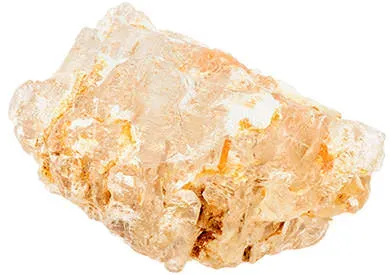 Petalite, also known as castorite, is a lithium aluminum silicate. It is a member of the "Feldspathoid" group. Petalite was first discovered in 1800 by the Brazilian mineralogist JB de Andradae Silva (1763-1838). Its name derives from the Greek words petalon, meaning leaf, (an allusion to its distinctive leaf-like, perfect basal cleavage) and lithos, meaning stone. The discovery of lithium was actually a result of petalite. In 1817, Swedish druggist Johann Arfvedson was analyzing petalite ore and discovered the lithium within it. Fine petalite is rare and very fragile. Because of its fragility, petalite is rarely cut, though sometimes cushion mixed cuts can be found. It is not the most popular mineral, but it is very collectable. Cut stones are usually only made for collectors as the stone's fragility makes it rare, expensive, and too brittle for everyday wear in rings. More often, the crystals are used for pendants and earrings, items that are less likely to be scratched or chipped when worn. Small petalite crystals are rare and the most fragile, and hardly ever reach 3 carats. Large petalite is more common, and is usually cut en cabochon.
Petalite, also known as castorite, is a lithium aluminum silicate. It is a member of the "Feldspathoid" group. Petalite was first discovered in 1800 by the Brazilian mineralogist JB de Andradae Silva (1763-1838). Its name derives from the Greek words petalon, meaning leaf, (an allusion to its distinctive leaf-like, perfect basal cleavage) and lithos, meaning stone. The discovery of lithium was actually a result of petalite. In 1817, Swedish druggist Johann Arfvedson was analyzing petalite ore and discovered the lithium within it. Fine petalite is rare and very fragile. Because of its fragility, petalite is rarely cut, though sometimes cushion mixed cuts can be found. It is not the most popular mineral, but it is very collectable. Cut stones are usually only made for collectors as the stone's fragility makes it rare, expensive, and too brittle for everyday wear in rings. More often, the crystals are used for pendants and earrings, items that are less likely to be scratched or chipped when worn. Small petalite crystals are rare and the most fragile, and hardly ever reach 3 carats. Large petalite is more common, and is usually cut en cabochon.
 Petalite resembles masses of feldspar and can be easily confused with feldspar. Distinguishing the two is usually done by optical tests. In flame tests, petalite gives off the red flame characteristic of lithium. Petalite crystals have a glassy appearance and occur as tabular or columnar prisms with a vitreous to pearly luster. They can be transparent to translucent and display a fluorescent iridescence. Petalite stones are found in a wide range of colors, from colorless to white, gray, green, greenish-white, yellow, yellow-gray, pink, reddish, and reddish-white. Petalite rates a 6 on the Moh's hardness scale. It also has a very brittle fracture.
Petalite resembles masses of feldspar and can be easily confused with feldspar. Distinguishing the two is usually done by optical tests. In flame tests, petalite gives off the red flame characteristic of lithium. Petalite crystals have a glassy appearance and occur as tabular or columnar prisms with a vitreous to pearly luster. They can be transparent to translucent and display a fluorescent iridescence. Petalite stones are found in a wide range of colors, from colorless to white, gray, green, greenish-white, yellow, yellow-gray, pink, reddish, and reddish-white. Petalite rates a 6 on the Moh's hardness scale. It also has a very brittle fracture.
 Petalite usually occurs in lithium-bearing granite pegmatites alongside minerals such as tourmaline, lepidolite, spodumene, and feldspars. It is found most often in large masses. Its type locality is Uto, Haninge, in Stockholm, Sweden. Other sources include Nuristan, near Afghanistan; Nepean, in Western Australia; Aracuai, in Minas Gerais, Brazil; Alto Ligonha, Zambezia, in central Mozambique; Karibib, in eastern Namibia; and the Buryatia Repubic, in eastern Siberia. It is also found in Ontario and Manitoba, in Canada, and in various locations around Germany, Italy, Sweden, Finland, Zimbabwe, and Madagascar. In the United States, petalite is found in Oxford County in Maine, Hampden County in Massachusetts, Middlesex county in Connecticut, Strafford County in New Hampshire, Cleveland County in North Carolina, Taos county in New Mexico, and Fremont County in Wyoming.
Petalite usually occurs in lithium-bearing granite pegmatites alongside minerals such as tourmaline, lepidolite, spodumene, and feldspars. It is found most often in large masses. Its type locality is Uto, Haninge, in Stockholm, Sweden. Other sources include Nuristan, near Afghanistan; Nepean, in Western Australia; Aracuai, in Minas Gerais, Brazil; Alto Ligonha, Zambezia, in central Mozambique; Karibib, in eastern Namibia; and the Buryatia Repubic, in eastern Siberia. It is also found in Ontario and Manitoba, in Canada, and in various locations around Germany, Italy, Sweden, Finland, Zimbabwe, and Madagascar. In the United States, petalite is found in Oxford County in Maine, Hampden County in Massachusetts, Middlesex county in Connecticut, Strafford County in New Hampshire, Cleveland County in North Carolina, Taos county in New Mexico, and Fremont County in Wyoming.
 Petalite has many physical and emotional attributes. It is a stone that helps cut ties with anyone from past, and supports independence. It enables the wearer to clears negative emotions and lessens emotional sensitivity. Petalite is a stone of compassion, promoting flexibility while maintaining gentle strength. Physically, when carried on the body, petalite constantly energizes and activates all the energy centers of the body. It has been said to benefit the wearer's eyes, cells, lungs, muscular spasms, and intestines.
Petalite has many physical and emotional attributes. It is a stone that helps cut ties with anyone from past, and supports independence. It enables the wearer to clears negative emotions and lessens emotional sensitivity. Petalite is a stone of compassion, promoting flexibility while maintaining gentle strength. Physically, when carried on the body, petalite constantly energizes and activates all the energy centers of the body. It has been said to benefit the wearer's eyes, cells, lungs, muscular spasms, and intestines.